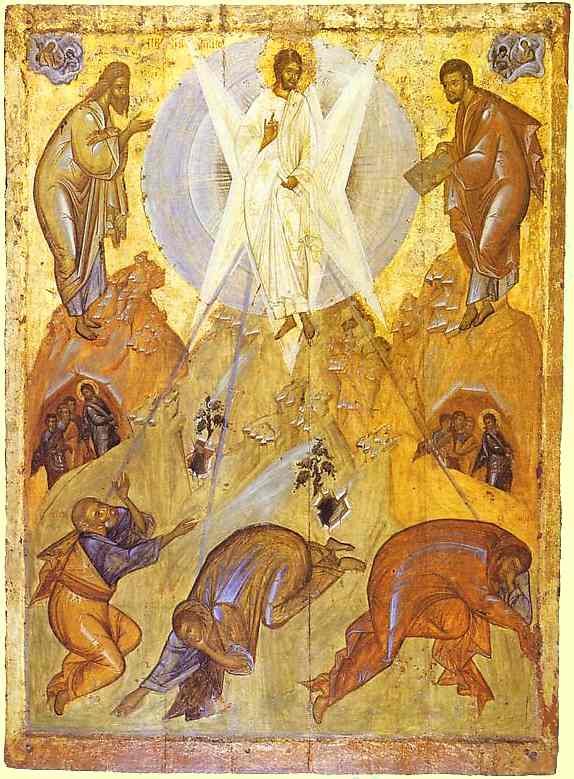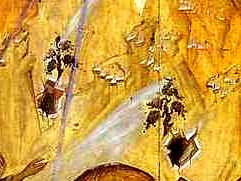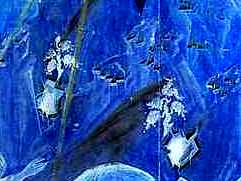|
EARLY 15th CENTURY RUSSIAN BONSAI?
"While at the Tretyakov Museum in Moscow looking at old icons, I spotted 'The Transfiguration' by Theophanes the Greek... The painting shows two very stylized bonsai, very green and small plants and two very small pots; each plant plus pot being barely 2 x 4 inches on an icon 3 x 5 ft." "...What I remember was that the two plants were actually in free fall. They were not inside in any crevices or animal hides [as some have suggested in response to the original post]. Many items in the icon seemed to be in a stream/flow from top of the icon to the bottom. The plants seemed to be somewhat separated from the pots. The color of the plants was a very strong green and the pots were a much more muted brown. Too bad that taking of pictures is generally forbidden in museums, so I can't provide any further detail." (Ed. Spanns, Grand Rapids, MI, in post to Internet Bonsai Club October 1, 2003; and his private email to Pat Patterson, Oracle, AZ, as she posted to the group October 5, 2003) From the Cathedral of the Transfiguration in Pereslavl, this tempura on wood piece measures 184 x 134 cm (72 x 52-3/4"). It is based on the Transfiguration of Jesus Christ as described by Luke (9:28-36). This Internet image of the icon can be found on http://www.abcgallery.com/I/icons/greek5.html Theophanes (c. 1335-c.1410) was of Greek origin and worked in Constantinople and other cities before coming to Moscow in 1395. Previous to this he lived in Novgorod, beginning in 1370. "It was the novelties of the last remarkable phase of Byzantine art, which coincided with the beginning of the Italian Renaissance, that [this accomplished artist] brought to Russia. With him came gradual changes in Russian painting; portraiture became more naturalistic, faces and garments softened, fresh combinations of colors were introduced, movements became rhythmic. Theophan was a great master of coloring and knew very well how to produce pleasant and bold effects. His frescoes compositions were artistically distributed and each figure he painted received a natural look, strikingly different from the previous ascetic rigidity. He painted from memory and with his inner feelings, rather than constantly referring to existing examples as others of his time did. He added to his paintings bits of real life and scenes from simple human relations [ emphasis added ]. The passage that he used for background contributed to the reality of the message that his frescos wanted to transmit. Theophan not only brought to Russia all these novelties of the reborn Byzantine art, but for the more than three decades that he lived in his adopted country, he did much to propagate them, and trained scores of young Russian painters." Only some of those works he produced on Russian soil have survived and he is therefore included in the history of Russian as well as Byzantine art. The richest source of biographical material is a 17th-century copy of excerpts from a c.1415 letter from the monk and hagiographer Epiphanius the Wise. He describes Theophanes, whom he knew well, as "a renowned wise man, an expert philosopher... a famous book artist and the best artist among all the icon painters. He indeed was an El Greco, great and with the traditional Greek instinct for beauty, and yet always unpretentious, who enriched art throughout the world more than anybody else." ("Grove Art Artists' Biographies, Theophanes the Greek," http://www.artnet.com/library/08/0844/T084474.asp ; "Russian Art and Architecture Through the Centuries, Theophanes the Greek," http://www.xenophongi.org/rushistory/artandarch/theophanes.htm ); "Theophanes the Greek (ca.1330-ca.1410)," http://www.rollins.edu/Foreign_Lang/Russian/theoph.html )
So, what inspired Theophanes to place
what appear to be two Japanese bonsai into a New Testament-themed religious
icon which dates to the beginning of the 15th century Russia? Wouldn't
full-grown olive trees on the mountainsides be truer to the story?
The portrayed miniature trees don't seem to be potted olives -- what are
they? The artist's brief biographies do not not indicate that he
travelled any farther east than Moscow. Where was he introduced to
the concept of miniature potted trees? Did he know of monks at some
Russian or Byzantine monastery who raised dwarf potted trees, either from
knowledge from Asia or independently developed? What do the trees
symbolize in relation to the story of the Transfiguration? Were
the trees, indeed, included in the original painting or were they later
add-ons? (Which raises additional questions as to when and by
whom they might have been added -- although we have
no
evidence that these were amendments to Theophanes' work.)
"The bonsai trees in an old Russian icon are obviously surprising. To discover their true meaning we should take a look on other images of the Transfiguration - Patrick Comerford did in his blogspot http://revpatrickcomerford.blogspot.com/2010/04/transfiguration-finding-meaning-in.html (q.v.). What we will find there is, that trees seem to be a part of the iconography of many Transfiguration scenes. Patrick does unfortunately not give us an idea about their meaning within this theme, on the other hand we could surely find a special one -- if looking for more seriously. The fact trees are there and the fact they are part of different images of different icon painters let us assume there must be a special meanning. Maybe we simply cannot read these symbols any more and should get in touch with Dan Brown`s symbol expert Tom Hanks? "But leaving the meaning question, the point is, that in all Transfiguration images with trees these are growing in the ground and only in the your mentionned one of Theophanes they seem to look like bonsais for the first view. Well, Patrick gives us brilliant copies of your image and a very similiar second icon, also attributed to Theophanes. Both of them do give us the idea, that these trees are not potted ones but trees growing out of a hole in the ground or a cave. We do see this also, if we take a look at the [larger] caves to the left and the right, where we will find some men inside. All holes/caves are painted in a very similiar way so we should cancel the thought about bonsai. "The Theophanes trees look Japanese for us, because they are in a way abstract and our eyes remember to know them as bonsais because they see a special style in them. The other trees in the other images are in a complete other way abstract. So, this is Penjing style? "This anomaly is a human one, telling us the story of seeing things our eyes want us to see. Without the pot there is no way to keep it as a bonsai in the meanning of a 'trained' or 'potted' tree to whatever purpose. "Last but not least I would ask in a different way about the 'Russian bonsai' to catch the path to another answer: what would a contemporary viewer say about the trees? I assume, he would read them as a symbol and in this context the form of representation does not matter, as long as it gives the impression 'tree' to the viewer. What task does a p o t t e d tree therefore have? "Maybe Theophanes simply felt aspired by his own tree collection and added his most beloved ones in this icon. The Russion bonsai monk? Well, this would be an anomaly! And perhaps the stuff for a new Dan Brown adventure." This last paragraph is obviously written with a twinkle in Sascha's eye. The very human trait of "Pattern Recognition" has thus come into play here. This illustration-out-of-time apparently is solved, especially in light of Patrick Comerford's examples of many other depictions of this same subject also having some sparse vegetation on the side of the mountain. For the sake of future researchers we shall leave this entry here, now framed in a different shade of gray than the rest of this article. "I hadn't [seen the above], but I have been looking at those trees and thinking they look an awful lot like bonsai. I think they are simply naturally dwarfed trees, but they make you think. Russian icons are very abstract in nature, especially in this time period, and elements are not shown in true proportion. Human figures are different sizes based on importance. Natural elements such as trees are there basically to fill what would otherwise be an empty space, but they wouldn't be large enough to distract from the subject at hand." Posting on Facebook 03-26-16 by Rev. Craig Lewis Cowing, a bonsai enthusiast and long-time student and replicator of orthodox christian icons, when RJB pointed out the above analysis. |


